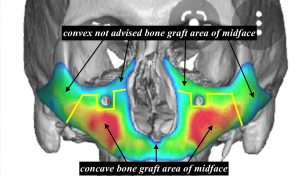Can I Use Cranial Bone Grafts For Midface Augmentation?
Q: Dr. Eppley, I have a problem with face retrusion as a complete front area of face. I have discussed my concern with one of my friend who has contacted you on the past. Acording to him you are very skilled on face augmentation by cranium bone grafts. So I’m interested in using bone grafts.I have 2 questions and I would be very grateful for your kind answers.
So:
1. When you harvest the bone from the head, how much thicken graft can be taken. For example 3 or 4 millimeters thicken graft. So on your experience how much is the maximum thicken graft that you can harvest from the head for face augmentation without any problem on the head on the future. This will help me having an idea if it will meet my wishes.
2. Does the bone graft may include complete front of face up to around the nose. So this way it is necessary using too much grafts. So only front of face starting from zygoma, orbital rim and all front face up to around the nasal bone and maxilla . For me it is important that bone grafts being up to nasal bones
To explain better you may see attached the foto with facial mask custom implant. So my wish is including complete front of face augmentation as implants in foto.
Can be achieved the same area augmentation by bone grafts. Is that any problem to augment full front of face up to around the nose and around the eyes by bone grafts. So not only cheeks or malars.
Many thanks for any answers.
A: Thank you for your inquiry and sending your illustration to which I can say the following:
1) While bone grafts may be appealing compared to implants for midface augmentation, they are comparable in terms of effect. They are not completely interchangeable concepts.
 2) Because of the hard inflexible (unbendable) nature of block cranial bone grafts, they can only be placed on concave midface surfaces. Trying to place them on convex midface surfaces will result in a lot of palpable/visible irregularities. To illustrate those different midface zones I have attached an illustrated diagram. (see attached) These convex areas may be treated by allogeneic (tissue bank) bone chips as they can be applied with less irregularities. How well such bone chips survive is variable.
2) Because of the hard inflexible (unbendable) nature of block cranial bone grafts, they can only be placed on concave midface surfaces. Trying to place them on convex midface surfaces will result in a lot of palpable/visible irregularities. To illustrate those different midface zones I have attached an illustrated diagram. (see attached) These convex areas may be treated by allogeneic (tissue bank) bone chips as they can be applied with less irregularities. How well such bone chips survive is variable.
3) The average thickness of most harvested outer table cranial bone graft is in the 4 to 5mm range.
4) Given the volume of bone grafts needed an argument could be made for use of rib grafts which are more easily harvested and are more flexible/bendable.
5) Only a custom midface implant can reliably cover all indicated areas in a smooth fashion. Thicknesses of such implants are what one designs them to be.
Dr. Barry Eppley
Indianapolis, Indiana

North Meridian Medical Building
Address:
12188-A North Meridian St.
Suite 310
Carmel, IN 46032
Contact Us:
Phone: (317) 706-4444
WhatsApp: (317) 941-8237
